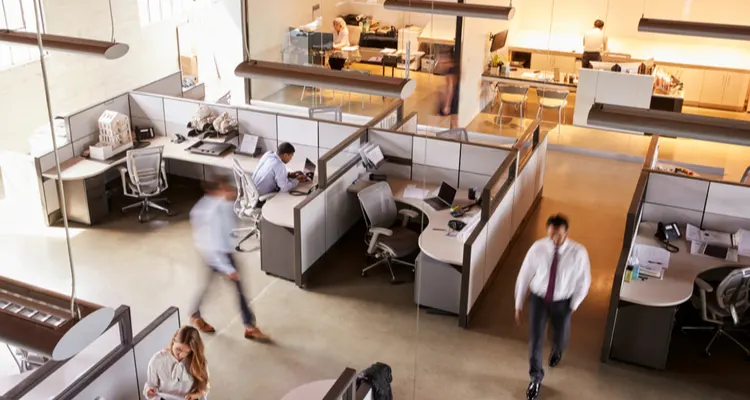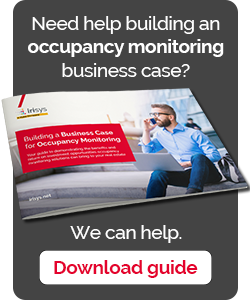Making meeting room booking efficient with occupancy sensors
Are your meeting rooms working for you?
How well do the meeting rooms in your office work for you? Are they an effective use of the space? Do you ever see your conference room being used by a mere smattering of individuals? Maybe your meeting rooms are overused, and you can never book a room when you need one. Are your meeting rooms the right size? Do you have enough or too many? Plenty of questions.
Perhaps it’s time to look at your meeting room booking process and the data surrounding this operation to find the answers.
You can use occupancy data to first find out how many people are using your rooms and for how long. A system like True Occupancy collects information via ceiling-mounted workplace occupancy sensors. These count people in and out of your meeting rooms and send the data to an AI cloud platform for analysis, reporting and integration with 3rd party systems. Accurate occupancy data from the True Occupancy solution goes a long way towards eliminating meeting room booking problems and ensuring that you’re making the most of your meeting room availability.
How occupancy sensors measure meeting room usage
People counting sensors are crucial for assessing the efficiency of your meeting room booking. They tell you not only about presence but also about the numbers occupying your meeting room at any particular time. Key features of the sensors include:
- The ability to count people in both directions - entering and exiting the room
- The devices are small and discreet - mounted on the ceiling at the entryway
- The ability to reassure your employees about privacy and confidentiality. The data is completely anonymous, so no-one can be identified.
Just as with desk sensors, you can capture the data immediately. It’s encrypted and transmitted to a cloud-based platform where you can view in real-time which rooms or spaces are being occupied.
With the meeting room sensors supplying all the data you need, the next step is to integrate this data with your meeting room booking software. The solution you go for needs to be one that integrates with your existing calendar tools (like Microsoft Outlook or Google Calendar) or booking system. It should eliminate double-bookings and allow your employees to easily reserve a meeting or conference room at short notice. Allow them to immediately judge the size of the room, the seating capacity and the equipment available. Provide them access through their desktop, laptop or a mobile app to enable remote reservations.
Access to real-time data also helps to eliminate ‘ghost’ bookings (ones that remain even after a meeting has been cancelled). For example, by integrating the occupancy solution with your room booking system, if the sensor detects a room is unoccupied 15 minutes after the scheduled meeting time, it will make the room available again so others can book it.
Benefits of using occupancy sensors for meeting room booking
Zombie meetings – where rooms are regularly booked for meetings, but, for any number of reasons, no meeting takes place – are increasingly common. Often it’s down to human nature - people are often disorganised, lazy or forgetful, or even all three. They can happen because an employee has booked a room weeks or months in advance and then left the company. Zombie meetings can happen simply for reasons for scale. A company might grow rapidly, occupying more floors in a building. They simply lose count of the meeting rooms available to them and become careless – booking two rooms on different floors when they only need one.
How much do Zombie meetings cost?
Take a look at these calculations, and you’ll soon understand the value of taking meeting room booking seriously. First, gather the following data -
- The size of your meeting room in square feet (length x width)
- The annual lease rate you’re paying per square foot
- The annual cost per square foot of your utilities
- Your average room utilisation/vacancy rate
Apply the figures into this formula: ([Lease Rate + Cost of Utilities] x Room Size)
The result is the total annual cost of one meeting room. To find out how much one empty conference room costs, multiply the result by the average vacancy rate. Here’s an example -
- Average annual lease rate £15/sq. ft.
- Average annual cost of utilities: £2/sq. ft.
- Average size of a large meeting room: 420 sq. ft.
Using these figures, the total annual cost of the room is £7,140. Assuming the space has a utilisation rate of 25 per cent (which is the average for most organisations), a single empty conference room can cost your business £5,355 per year.
The good news is … using occupancy sensors, along with appropriate software for meeting room booking, can dramatically reduce this cost.
What about meeting room booking and COVID?
With the enforced use of online meeting platforms such as Zoom, the demand for physical meeting rooms will change – but certainly not disappear altogether. You need to communicate to your employees that you take their health seriously and that their safety is your number one concern. You can use your automated meeting room booking system to account for the size and configuration of your meeting rooms and limit the number of employees per booking to help with social distancing.
Sanitise after every use
You’ll also need to remember to sanitise all surfaces before and after every meeting room booking. Integrating your occupancy sensors with both a cleaning scheduling app and meeting room booking app, means in between bookings, you can make sure cleaners are informed when a meeting has just finished, enabling them to go in and clean the space. Not only this, but it will help if you factor into your reservation platform ‘buffer time’ between meetings to enable sanitising to take place. For longer meetings (maybe 2 hours or more), consider allowing time for sanitisation breaks during the meeting.
Use automated meeting room booking to improve productivity
There’s a common misconception among employees that there’s never enough meeting room space. But is this necessarily true? The statistic showing, 4 in 10 office workers spend around 60 minutes every week searching for available conference rooms, indicates the remark is true, while also demonstrating employee productivity is being lost due to inefficient meeting room booking. Occupancy sensors and the resultant data they generate will give you a true picture of the efficiency of your meeting room arrangements. Here are just a few examples of what can go wrong –
- Large meeting rooms rarely hit capacity.
- Only certain conference rooms have certain amenities (e.g., A/V systems).
- Meetings include video participants, but the room is booked for the total number of attendees, not the number of people physically present.
- Departments that meet frequently are located on different floors or even in separate buildings.
- The closest conference room doesn’t match a team’s typical meeting size.
- Zombie meetings tie up rooms when recurring meetings aren’t cancelled when not needed.
- Meeting rooms are perceived to “belong” to a certain department or floor.
- Boardrooms can’t be reserved by the general staff.
- People get comfortable booking what they know, not what’s the most efficient room size.
- There’s no incentive (or consequence) when booking a room that isn’t the right size.
- The style of furniture or décor can impact negatively on the popularity of a meeting room.
Save time and space with better meeting room booking
You can use occupancy data and room booking software to arrange when and where employees meet and also how they gather, and you can do it in such a way as to save a vast amount of time and space – and, therefore, money. You can do this in the following ways -
Improve space utilisation - Understand how your meeting rooms are really used and ensure you have the right amount, and they are the right size for your needs.
Reduce meeting no shows - Minimise the disruption and loss of productivity that meeting no shows cause.
Reduce wasted time - Ensure it is used productively and reduce the amount of time they spend looking for available rooms.
Real-time data – Integrate data from True Occupancy so that it can be displayed live on employee apps, intranets or display screens.
True Occupancy – providing occupancy data to make meeting room booking solutions better
True Occupancy offers one of the most comprehensive occupancy data solutions on the market. Our occupancy sensors connect to an intuitive dashboard that gives your property and facilities management teams immediate insight into a building's real-time utilisation. Our devices are non-intrusive, protect the privacy of occupants, and provide a cost-effective means of scaling your monitoring strategy as and when you need to. Take a look at our occupancy analytics solution in action by requesting a demo here.
Share this
You May Also Like
These Related Posts

What is a Smart Building?

Embracing Occupancy Analytics: A Q&A with James McHale

Choosing the best occupancy sensor: 6 considerations to make before selection
Connect with us
Need more information? Ready to get started? We're here to help, get in touch.


